MAIZE DISEASES- SYMPTOMS & CONTROL
Downy mildew/Crazy top
Causal organism- Peranosclerospora sorghi
Occurrence
- Favourable Conditions include low temperature (21-33˚C), high relative humidity (90%) and drizzling.
- Young plants are highly susceptible.
Symptoms
- Chlorotic streaks appear on the leaf and white fungus growth is seen on both the surfaces of leaf.
- Affected plants become stunted and exhibit bushy appearance due to shortening of internodes.
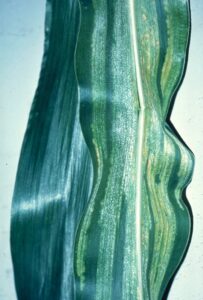
Management
- Rogue out affected plants.
- Use resistant varieties.
- Soil application of P. fluorescens or viride @ 2.5 kg / ha + 50 kg of well decomposed FYM (mix 10 days before application) or sand at 30 days after sowing.
- Spray Metalaxyl @ 1000g or Mancozeb 2g/lit at 20 days after sowing.
Turcicum Leaf Blight
Causal organism- Exserohilum turcicum
Occurrence
- Optimum temperature for the germination of conidia is 8 to 27˚C provided with free water on the leaf; Infection takes place early in the wet season.
Symptoms
- The fungus affects the crop at young stage.
- Oval, water-soaked spots on leaves first which develops characteristic cigar shaped lesions at maturity.
- Lesions are elliptical and tan in color, developing distinct dark areas as they mature that are associated with fungal sporulation.
- Lesions typically first appear on lower leaves, spreading to upper leaves and the ear sheaths as the crop matures.
- Under severe infection, lesions may coalesce, blighting the entire leaf.
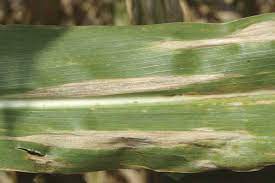
Management
- Crop rotation with a non-host crop like legumes.
- Destruction of crop debris.
- Use of resistant/tolerant hybrids.
- Seed treatment with Azospririllum @ 25 g and Trichoderma @ 6g per kg seeds or Thiram 75 WP @ 2 g or Capatn 50 WP @ 2 g/kg of seeds before sowing.
- Spray 2.5g Mancozeb 75 WP or 1 ml Hexaconazole 5 EC per liter of water immediately after appearance of the disease symptoms. Repeat the same after 15 days.
Maydis Leaf Blight
Causal organism– Biopolaris maydis
Occurrence
- Optimum temperature for the germination of conidia is 8-27˚C provided with free water on the leaf; Infection takes place early in the wet season.
Symptom
- Small yellowish round or oval spots appear on the leaves. These spots enlarge, become elliptical and the center becomes straw coloured with a reddish brown margin.
- Conidia and conidiophores are formed in the center.
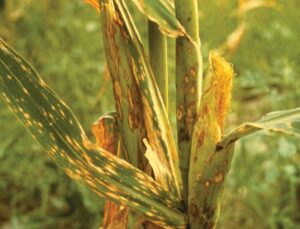
Management
- Destroy infected crop residue from the field.
- Grow resistant cultivars- Deccan, VL 42, Prabhat, KH-5901, PRO-324, PRO-339, ICI-701, PEMH 1, PEMH 2, PEMH 3, Paras, Sartaj, and COH-6.
- Foliar spray of Mancozeb @ 2.5 g/lit of water about 15 days after sowing is effective and provide two more sprays at 10-day intervals or immediately after symptoms appearance.
Charcoal rot
Causal organism- Macrophomina phaseolina
Symptoms
- The pathogen affects the plant mostly after flowering and the disease is named as Post Flowering Stalk Rot(PFSR).
- The stalk of the infected plants can be recognized by greyish streak.
- The pith becomes shredded and greyish black, minute sclerotia develop on the vascular bundles.
- Shredding of the interior of the stalk often causes stalks to break in the region of the crown. The crown region of the infected plant becomes dark in colour.
- Shredding of root bark and disintegration of root system are the common features.
- High temperature and low soil moisture (drought) favours the disease.
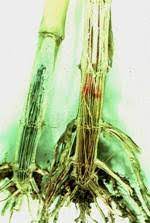
Management
- Adopt crop rotation.
- Deep summer ploughing.
- Field sanitation.
- Avoid the water stress condition at the time of flowering.
- Grow resistant/tolerant hybrids.
- Seed treatment with 25g PSB (Pseudomonas striata H-21) and 6 g Trichoderma harzianum
Fusarium stalk rot
Causal organism- Fusarium verticillioides
Symptom
- Leaves turn from a healthy green color to a dull green and the lower stalk becomes yellowed.
- Premature plant death may occur and lodging due to disintegration of the internal stalk pith tissue; when squeezed between the thumb and index finger at the lower nodes, the stalk often collapses.
- Dry conditions early in the growing season followed by above average rainfall and a temperature ranging from 80° to 100° F favours the disease.
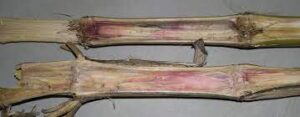
Management
- Field sanitation and deep ploughing.
- Adopt crop rotation.
- Apply balanced dose of fertilizers (Low dose of Nitrogen and high dose of potassium).
- Use of resistant/tolerant hybrids
Bacterial stalk rot
Causal organism- Dickeya zeae
Symptom
- Discoloration of the leaf sheath and stalk at a node. As the disease progresses, lesions develop on the leaves and sheath, rapidly spreads up the stalk and into the leaves.
- As the decay progresses, a foul odor can be detected and the top of the plant can be very easily removed from the rest of the plant. The stalk rots completely and the top collapses.
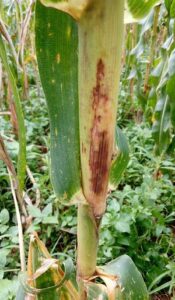
Management
- Destroy the diseased plant debris.
- Maintain the adequate drainage.
- Use of resistant/tolerant hybrids.
- Drenching of bleaching powder Ca (ClO) 2 with 1.5g/15 lit of water immediately after symptoms appear.
Corn rust
Causal organism- Puccinia sorghi
Symptoms
- Brown pustules are seen on both surface of leaf which represents the uredosori of the fungus.
- The alternate host is Oxalis corniunlata.
- Cool temperature and high relative humidity favours the disease.
- Optimum temperature for the germination of conidia is 10 to 12˚C
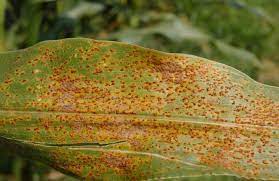
Management
- Field sanitation and crop rotation.
- Ploughing down of crop debris may reduce early infection.
- Spray Dithane M-45 @ 2.5-4 g/lit of water at first appearance of pustules. If disease is severe three sprays at 15 days interval are recommended.
Non-Insect Pest- Maize cyst nematode
Causal Organism: Heterodera zeae
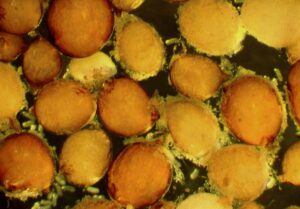
Management
- Crop rotation with non-cereal crops like soyabean, cotton and vegetables.
- Deep summer ploughing.
- Intercropping of maize with sesamum for the management of maize cyst nematode, Heterodera zeae on maize followed by Maize + soybean and Maize + cluster bean.
- Use of resistant/tolerant hybrids.
See also…
RICE DISEASE- SYMPTOMS & MANAGEMENT
WHEAT DISEASE- SYMPTOMS & CONTROL